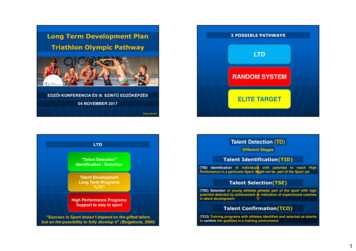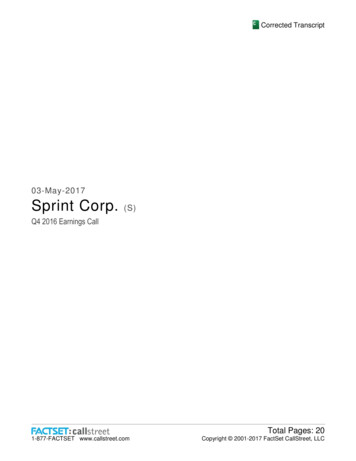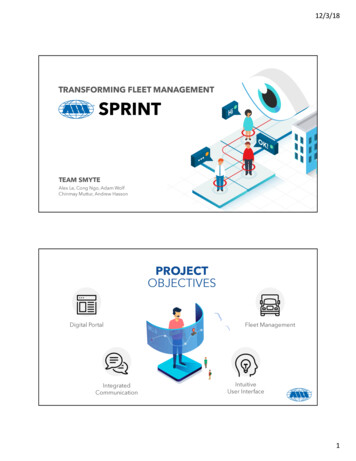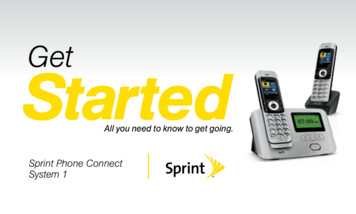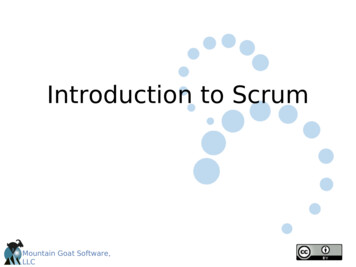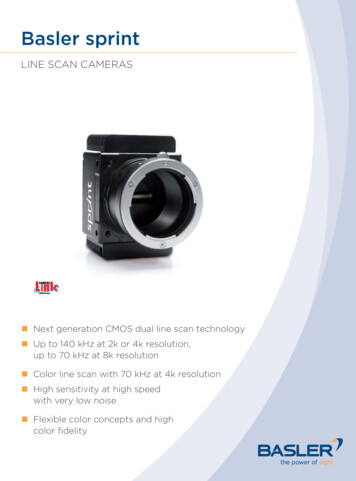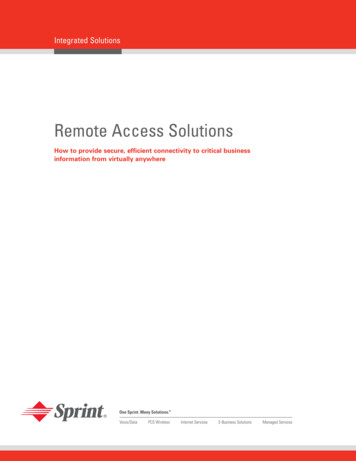
Transcription
Integrated SolutionsRemote Access SolutionsHow to provide secure, efficient connectivity to critical businessinformation from virtually anywhere
2Remote Access SolutionsExecutive SummaryDuring the past several years, the landscape of the global workplace has changed substantially.In an effort to keep pace with economic pressures, many organizations are now competing withfewer capital and human resources. Employees now dedicate more time to work — fromchecking e-mail and voice mail before leaving for work to taking unfinished assignments home— at a time when most seek a better balance between their workday and their personal life.The end result is a workforce that relies on various technologies to deliver secure, efficientaccess to critical business information from any location and at any time of the day. Thesetechnologies make up the Sprint Remote Access Solutions.The purpose of this white paper is to introduce enterprise customers to the benefits that remoteaccess can deliver to both the enterprise and its employees, the network components that makeup a total remote access solution and the Sprint approach to remote access.Market and technology highlightsexpected to increase from 80.6 million in2002 to 99.3 million in 2007 1The demand for remote access. Severalimportant trends have emerged from the introduction of remote access into the workplace.Organizations around the world are providingemployees with the flexibility to access important company data without having to be in theoffice. Creating more flexible work conditionsyields company benefits such as reduced costs,improved productivity, better employee retention rates and improved communicationsbetween geographically dispersed work groups.Consider these points: IDC, a global IT market intelligence and advisory firm, estimates that the number of U.S.mobile workers will grow by almost 13million, from 91.8 million to 104.5 millionindividuals between 2002 and 2006. Thisincrease that is almost twice that of the U.S.worker population in general. In WesternEurope, the mobile worker population is In-Stat MDR, a major market research firm,calculates that the United States has morethan 78 million remote and mobile workers,roughly 55 percent of whom workfor corporations 2 Employees using broadband to telecommuteonce a week report an average 33 percentincrease in productivity. When added to thepotential real estate savings that employerscan realize by reallocating office space, thebenefits of having a telecommuting policytranslate to an average cost savings to theenterprise of 5,000 per teleworker 31U.S. Mobile Worker Population Forecast and Analysis, 2002 - 2006(IDC #27374) and Western European Mobile Working Forecast andAnalysis, 2002 - 2007 (IDC #28548)2Working the Wide Area: Perceptions of Internet & WirelessAccessible Applications Among Mobile & Remote Workers,Part Two: The Corporate Market (In-Stat MDR #OC0108MD)3The 2003 Telework America Survey by Joanne H. Pratt & Assoc.
Remote Access Solutions3Definition of termsThe impact of an effective remote access policyis clear for many companies: Nortel Networks saves 40 million on annualreal estate costs while reporting consistentlyhigh employee satisfaction and companyloyalty 4Code division multiple access (CDMA).A form of digital, spread-spectrum technologythat transmits encoded speech bits over theair and reassembles the bits to their originalspeech format.3G. A third-generation wireless standard By allowing its workforce to telecommute,a large services company saved 5 milliona yearbased on CDMA 2000 that increases the speed,efficiency and feature functionality of mobilecommunications.The technology behind the solution. TheVirtual private network (VPN). A privatecommunications network that uses a sharednetwork and traffic separation, tunneling orencryption technologies to offer the appearance and functionality of a dedicated privatenetwork at a reduced price.hardware, software and network infrastructureavailable today make virtually anywhere, anytime access a viable solution for organizations.Laptops are now enabled for mobility andportability. Wireless phones are smaller, smarterand Internet-ready while personal digital assistants (PDAs) are evolving into multi-functionaldevices capable of functioning as both a phoneand a data device.Security has also improved greatly in recentyears. Through virtual private network (VPN)and security services, end users can connect toa corporate LAN using the latest encryptiontechnology. IT administrators have a greaterarray of tools available for network monitoring,authentication and security.Businesses now have several solutions thatdeliver network access across a variety of worksettings. In the office, wired Ethernet LANs,wireless LANs and wireless messaging devicesprovide high-speed, flexible, cost-effectiveconnectivity. Wireline broadband has beenadopted by hotels, restaurants, conventioncenters, airports and homes using digital subscriber line (DSL) and cable modem services.And wireless networking touches all of theselocations with the advent of 3G and wirelessLAN coverage in key business centers aroundthe world.4Nortel Networks Case Study: Nortel Networks Home WorkersIP VPN. An IP security (IPSec)-based VPN thatuses encryption and authentication to offer theappearance and functionality of a private datanetwork over a shared IP network such as theInternet. In this paper, IP VPN will be discussedin terms of both Sprint premises-based andnetwork-based IP VPNs.Spread spectrum. A security technique usedin wireless transmissions where data is packetized, mixed with frequency-modulated “noise”and spread over a wider range of bandwidththan the content of the original data streamrequires, making transmission eavesdroppingor jamming nearly impossible.Wireless LAN (WLAN). A local area networkthat delivers major benefits, the biggest beingthe ability to configure and reconfigure the LANquickly and cheaply, as wires need not beinstalled and moved.Wi-Fi. The popular term for a high-frequencywireless LAN. Wi-Fi, WLAN and 802.11 areoften used interchangeably to describehigh-speed wireless networking.
4Remote Access SolutionsSprint is one of the only service providerswhich can deliver a comprehensive remoteaccess strategy: wireless, wireless LAN andsecure, high-speed wireline connectivity.When selecting a service provider to deliver awide variety of the network and softwaresolutions behind remote access, it is importantto look for a provider that has expertise inproviding all of the components of a totalremote access solution, not just one pieceof the equation.Sprint is one of the only service providerswhich can deliver a comprehensive remoteaccess strategy: wireless, wireless LAN andsecure, high-speed wireline connectivity.Sprint networks: the power behindremote networking and mobilityLong before ubiquitous access became abusiness necessity, Sprint provided a way forremote, wireline-based networking by buildingthe first 100 percent native IP network fromthe ground up. Instead of site-to-site connectivity, such as frame relay or private line networking, IP technology can allow connections to berouted through the public Internet, increasingthe scalability and accessibility of a company’snetwork. In short, IP provides the foundationfor mobile connectivity.The public Internet is not inherently secure,however. To deliver enterprise-grade security toIP technology, Sprint relies on IP-based VPNs.IP VPNs provide the tunneling and encryptionrequired for business users to safely accesstheir critical applications.Sprint also pioneered wireless networking bydeveloping the first all-digital, CDMA-basedwireless network in the United States. Today,Sprint has the most complete all-digital wirelessnetwork in the nation providing exceptionaltechnology, coverage and speed. Wireless business professionals now have unsurpassedaccess to company data and Internet resources,allowing for improved levels of productivitybeyond the traditional confines of theenterprise network.Sprint IP and IP VPNsSprint has received numerous awards for thereliability and performance of its global nativeIP backbone. The Sprint IP network can deliverOC-192 capacity throughout the United States,Europe and Asia — reaching more than 100countries. Dedicated Internet access providesenterprises with reliable, high-performing connectivity to the Internet with a wide range ofaccess bandwidths, industry-leading servicelevel agreements, quality of service and an arrayof value-added products and services.The flexibility and ubiquity of the Internet hasmade it a logical substitute for the private linesor other wide area network (WAN) solutionsthat many companies use today to connecttheir remote locations. To accomplish communication across an IP network without sacrificing privacy, however, enterprises are turning toIP-based VPNs that use security measuresspecifically developed for the Internet. IP VPNsuse a protocol known as IP security, or IPSec,to ensure the privacy of data traveling over thepublic Internet. The Internet Engineering TaskForce (IETF) developed this protocol to authenticate and encrypt data within an IP network.At the most basic level, all VPNs serve the samepurpose — they permit organizations tosecurely share data with key stakeholders.Sprint can provide industry-leading IP VPNsecurity standards for our enterprise users
Remote Access Solutions5ConcentratorRemote officesDSLCablePOPCentralofficenetworkSprint IP BackboneRouterPOPPIXTeleworkersMobile employeesBusiness-to-BusinessextranetsCommon Uses of an IP VPNBranch offices, telecommuters and mobile employees typically use an IP VPN to gain access to the company intranet.Authorized suppliers, distributors and customers often use it to gain access to the company’s extranet. Access methodsrange from traditional dial-up and wireless to DSL.through the implementation of the followingthree components: Authentication — the first step to deliveringsecurity is to ensure that network users arewho they claim to be. Authentication provides authorization to users based on certaincredentials and verifies that data sentbetween two users has not been altered bya third party Encryption — encoding data before it istransmitted and delivering it in a way that canbe quickly deciphered by the authenticatedreceiver forms the second critical element tonetwork security. Encryption allows sensitiveinformation to traverse a public networkwithout compromising the confidentialityof the data Access control — this security measure complements IPSec. This concept focuses onblocking unwanted users from gaining accessto an internal network. Access control istypically achieved through authentication forIPSec trafficAs businesses support more remote users, VPNscan be designed to support high network avail-ability to ensure that mission-critical dataarrives on time. Moreover, IP-based VPNs can bedeployed and integrated easily with existingnetwork infrastructures, enabling enterprises toscale operations to meet the expandingdemand for remote access.Delivering 3G wirelessnetwork technologyIn the wireless world, Sprint can deliver thenetwork capacity and security that can meetthe needs of existing and future mobile applications. Sprint uses CDMA technology to providesecure, reliable data communications.CDMA has several important features: Improved security and privacy — CDMA’sdigitally encoded, spread-spectrum transmissions resist eavesdropping. Designed with 4.4trillion codes, CDMA virtually eliminatesunauthorized usage of another person’sphone account — known as cloning — andcall interception Voice clarity and call quality — CDMA filtersout background noise, cross talk andinterference so customers can enjoy crystal-
6Remote Access Solutionsclear calls, greater privacy and enhancedcall quality Fewer dropped calls — CDMA’s patented“soft handoff” method of passing callsbetween cells sharply reduces the risk of disruption or dropped calls during a handoff. Ahandoff occurs when a user moves betweenthe radio towers that relay cellular signals Greater capacity — CDMA allows the largestnumber of customers to share the same radiofrequencies, up to 10 to 20 times the capacityof analog equipment and more capacity thanother digital platformsSprint can provide the powerful and flexiblefeatures of its enhanced nationwide PCSnetwork within the bounds of sound securitypractices and proven security technologies.Wireless business professionals haveunsurpassed access to company data andInternet resources, allowing for superiorlevels of productivity outside the traditionalconfines of the enterprise network.Sprint can provide the powerful and flexiblefeatures of its enhanced nationwide PCSnetwork within the bounds of sound securitypractices and proven security technologies.Wireless business professionals have unsurpassed access to company data and Internetresources, allowing for superior levels of productivity outside the traditional confines ofthe enterprise network. Like VPN for wirelineIP-based networking, the CDMA technologyused in the enhanced Sprint nationwide PCSnetwork has many layers of added security thatmake it difficult to intercept. Voice and datatraffic travel through six levels of encoding andencryption before reaching their destination:1. Source coding — the network compressesand digitizes voice calls and breaks downdata transmission into small packets2. Channel coding — data units are encodedwith redundant information that more thandoubles their size. At this stage, the observedbits bear no resemblance to the original input3. Interleaving — the network breaks downdata units into smaller segments and interleaves —or intermixes — these segmentswith each other.The resulting string of bits,with each subsequent bit coming from adifferent segment, protects the source information from errors and further complicatesany attempts at recovering source information4. Encryption — next, data units are scrambledrandomly according to a long-code sequencethat is synchronized with the receiving deviceand then combined with a secret value knownonly by the enhanced Sprint nationwide PCSnetwork and the mobile device5. Spreading — the network then replaces eachbit in the encrypted data units with one of62 possible 64-bit Walsh codes. The sourceinformation at this point has been spread tosuch a size that it requires the full 1.25 megahertz of CDMA bandwidth, which it shareswith other users. Mathematical characteristics of the Walsh code allow each receivingdevice to recover its own information fromamong others transmitted simultaneously,based on the device’s knowledge of itsassigned Walsh code6. Modulation — the spread data units arecombined with other user traffic and controlchannels and modulated or shifted onto two1.25 MHz bandwidth radio carriers with thesame frequency but 90 degrees out of phase.
Remote Access SolutionsThe data is further scrambled by a 32,768-bitshort code during the modulation processThese six security phases make interception byunintended recipients nearly impossible. Theprocessing steps are unique to CDMA technology. Alternatively, technologies such as globalsystems for mobile (GSM) or time division multiple access (TDMA), assign a user’s voice ordata session to a particular time slot on afrequency where the user’s traffic is easierto intercept.Someone attempting to intercept wirelessCDMA traffic would not only be faced withundoing the complex processing steps, butwould also need to know certain informationcodes known only by the network and the targeted user’s mobile device. A would-be hackerwithout this information would have to try all4.4 trillion possible codes. Additionally, potential hackers would have to correctly reverse allprocessing steps before learning if they hadmade the right guesses at the different stagesalong the way, since all content is unrecognizable until reaching its destination.Sprint broadband: transformingbusiness through DSL andwireless LANsHigh-speed Internet access — popularlyknown as broadband — has finally become amainstream source of connectivity for remoteworkers. According to Faulkner InformationServices and the DSL Forum, the market for DSLservice is expected to reach 200 million usersworldwide by 2005, of which one-third willcome from the United States.5 More than 70percent of companies with 5,000 or moreemployees with remote access to the corporateLAN support DSL access.6Sprint DSL service has become a viable optionfor enterprises seeking to establish a broadbandInternet connection for their employees orsatellite offices. It is robust enough to supportInternet access, corporate connectivity viaVPNs and extra voice channels.DSL is an “always-on” technology that carriesvoice and data over existing copper telephonelines. It utilizes unused frequencies on theselines to transport traffic at multi-megabitspeeds. The service supports applications thatare bandwidth-intensive, such as streamingvideo, application programs and video conferencing. The technology is advantageous in thatthe user can leave an Internet connection on,but still use the phone line for voice calls.Sprint DSL operates at peak speeds greater thana regular modem connection — at speeds up to1.5 Mbps versus 56 Kbps for regular dial-upconnections — and is available in more than 60U.S. metropolitan areas. Data traffic travels overthe Sprint IP backbone and service is backedby top-tier customer support and service assurance. Finally, Sprint provides IP VPN andfirewall services to all DSL users.Where copper lines end, wireless broadbandbegins. Sprint Wi-Fi services, built on wirelesslocal area network technology, provide userswith access speeds that are faster than wirelinebroadband methods like DSL in the publicspace, without the need to be tied tonetwork lines.Demand for wireless services is forecasted togrow rapidly, with more than 5.5 million peopleexpected to use WLANs in public spaces suchas restaurants, hotels, convention centers andairports by 2006.75Digital Subscriber Line (DSL) Market Trends (Faulkner InformationServices #00016504)62002 U.S. WAN Manager Survey (IDC #28965, Volume 1)7U.S. WLAN Hotspot Forecast and Analysis, 2002-2007: Islands inthe Storm (#29487)7
8Remote Access SolutionsFor enterprises adopting wireless technologiesfor use in private office environments, wirelessLANs provide a way for businesses to easilyscale their operations to better meet marketconditions. When businesses grow or move,the Sprint wireless LAN infrastructure candeliver productivity and scalability by allowingusers to access mission-critical data when andwhere they need it while lowering costs tothe enterprise of IT management and wiredbuild-outs.Hybrid wireless LANs allow enterprises toleverage their network investment to createvalue-added services for customers.Sprint offers three types of wireless LANdeployments to meet a variety of customerrequirements: PCS Wi-Fi Access — this Sprint service canprovide wireless coverage in concentratedpublic spaces in situations where users aremore likely to be in a particular location foran extended period of time and where theyhave the greatest need for high-speed accessto bandwidth-intensive applications. In addition to corporate campus environments, PCSWi-Fi Access users can also take advantage ofthe service in more than 800 public locations,such as airports, convention centers andhotels — at peak speeds of up to 11 Mbps.PCS Wi-Fi Access is expected to be availablefrom more than 2,100 compatible Wi-FiZONETM locations by the end of 2003 Private wireless LANs — Sprint can providewireless high-speed connectivity for businesses within a corporate complex orcampus. Sprint has already worked with Cisco82002 U.S. WAN Manager Survey (IDC #28965, Volume 1)Systems to deploy wireless solutions to majorhotel chains and university campuses Hybrid solutions — this offering combinespublic and private wireless LANs. Enterprisescould use the wireless LAN for their employees to access company-specific data whilealso allowing customers, visitors and othersto use the network for Internet access whileat their location. As an example, an airlinecarrier may use the wireless LAN to conductday-to-day business activities that includemaking flight reservations and handling baggage. At locations within an airport wherethese activities take place, a business travelermay use the airline’s wireless LAN to e-maildocuments, connect to a corporate VPN orsurf the Internet. Hybrid wireless LANs allowenterprises to leverage their network investment to create value-added services forcustomersDial-up access: reliablenetwork connectivityIf broadband technology represents the risingstar of the remote access world, dial-up connectivity is its reliable workhorse. Most businessusers would prefer to have the speed of broadband wherever they go. But what happenswhen a broadband or wireless connection isunavailable? Dial up is still used by more than95 percent of companies with 5,000 or moreemployees with remote access to thecorporate LAN.8Sprint Dial IPSM can provide enterprises withessential Internet and intranet access throughmore than 16,000 points of presence in morethan 140 countries. The service includesauthentication and encryption capabilities thatfully integrate with Sprint VPN and securityservices, providing an end-to-end solution thatcan provide protection for customer data.
Remote Access SolutionsMoreover, the Sprint advanced SS7 networktechnology can deliver fast expansion into newservice areas, fast deployment of additionalcapacity and a scalable path for leading IP technologies to be added to an existing networkplatform. This means customers can count onhaving the connectivity they require throughan ever-growing network.Finally, the Sprint remote access software clientprovides one platform to access the Internetthrough multiple devices and connectivityoptions. All of this adds up to ubiquitous,dependable Internet access for enterprisecustomers when they need it most: a criticalcomponent to any remote access solution.PCS Clear Wireless WorkplaceSMBeyond the power and stringent security measures built into the enhanced Sprint nationwidePCS network, Sprint has redefined the environment for mobile productivity by developingspecific solutions to meet enterprise needs.Business professionals now benefit from: Exceptional clarity — 3G network technology can provide fast transmission speeds,robust graphics and clear signals Advanced data products — integrated phoneand PDA products deliver multiple businessfunctions through one device Account management tools — secure Webbased usage reports allow customers toreview and customize PCS billing informationbased on their structure and reportingrequirements Pricing and corporate discounts — pricingplans are designed specifically to meetenterprise cost management requirementsAll of this translates into a more agile workforce, supplied with the devices, network andsecurity to access mission-critical applicationswhile on the go.The PCS Clear Wireless Workplace is a full suiteof wireless products and services designed tomeet the needs of the mobile workforce.Sprint offers a range of advanced voice products, management solutions and, with PCSVisionSM, a new standard of integrated multimedia devices and services using the enhancedSprint nationwide PCS network. This rangeincludes the following service components: PCS Business ConnectionSM — most employees would find it difficult to determine whichis more vital to their productivity: e-mail orphone service. So when Sprint developed PCSBusiness Connection, it created a system forwireless e-mail that took the needs of thebusiness customer seriously. PCS BusinessConnection can be deployed to suit any corporate IT philosophy, both as a managed service or as an IT managed server that residesbehind a firewall. There’s even a personaledition that enables individual employees toretrieve their e-mail right from their desktopcomputers — no IT staff interventionrequired. And e-mail can be sent andretrieved from a broad range of devices,whatever suits the needs of your employees PCS Data LinkSM — this service is for mobileemployee’s who need to take their entire network on the road with them. By establishinga secure, private connection between theemployees’ network and the Sprint PCSnetwork, remote workers can gain access totheir intranet, e-mail, business applicationsand shared drives as well as controlled accessto the Internet PCS Wi-Fi Access — wireless LAN deployments in public spaces are becoming a phenomenon in the United States and abroad.Historically, the service has been offered by9
disparate “hot spot” providers, delivering aninconsistent user experience from onelocation to the next. PCS Wi-Fi Access allowsusers to seamlessly toggle between PCSVision, using their PCS phone or PDA, andWi-Fi service, using their laptop computer.PCS Wi-Fi Access provides a single, integratedsoftware client that provides customers witha consistent user experience and billingmodel throughout all Wi-Fi zones Wireless web — for employees who rely onWeb access, PCS Vision can deliver that, too.Mobile employees need never be away fromthe online resources that their office-boundcolleagues depend on every day Messaging — for those times when short-textmessaging or Web-based e-mail is the mediumof choice, Sprint Messaging is availableacross the enhanced Sprint nationwidePCS network Advanced voice services — PCS VoiceCommandSM provides hands-free dialing topersonal and business contacts; PCS Integrated OfficeSM integrates multiple office andpersonal phone and voice mail accounts intoone; and PCS International Roaming enablesemployees to be in touch across multipletime zonesConclusionThe notion that the ideal workplace is builtexclusively out of a wired, single location isquickly disappearing as technologies emerge tomeet the dual business challenge of loweringcosts while increasing employee productivity.Enterprises and workers both stand to gain asdispersed wireline connectivity, wireless LANand mobile access to critical informationbecome the standard protocols for doing business. As companies consider service providersto deliver integrated, enterprise-wide remoteaccess solutions, Sprint should rank at the topof their lists. Sprint is a service provider thatowns all of the components of an effectiveremote access strategy: Wireless voice Wireless LANs Dial-up IP access Broadband connectivity IP VPNs Global reachPlease contact your Sprint SalesRepresentative orAuthorized Sales Agent1-800-786-6272www.sprintbiz.comCopyright Sprint 2003. All rights reserved. Sprint, the diamond logo design, PCS Clear Wireless Workplace, PCS Business Connection, PCS Data Link, PCS Vision, PCSVoice Command and PCS Integrated Office are trademarks of Sprint Communications Company L.P. All other trademarks are the property of their respective owners.09.0303107
2 Remote Access Solutions Market and technology highlights The demand for remote access. Several important trends have emerged from the intro-duction of remote access into the workplace. Organizations around the world are providing employees with the flexibility to access impor-tant company data without having to be in the
